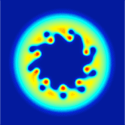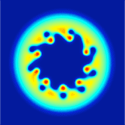Wind blowing over an ultracold sea
Kelvin-Helmholtz instabilities can occur at the interface between two fluids in relative motion. This happens, for example, when wind blows over the surface of the sea, forming waves, as well as in many similar situations involving immiscible classical fluids. It also occurs in more exotic cases, for instance, at the interface between two superfluids, such as the A and B phases of superfluid helium- 3. On the other hand, if the two fluids are partially miscible and their interface is thick, a different dynamical instability, known as counter-superflow instability, may also arise.
In a paper published in Physical Review A, Naoya Suzuki at the University of Electro-Communications in Tokyo and collaborators, also in Japan, show that gaseous two-component Bose-Einstein condensates may represent an ideal testing ground for textbook concepts of fluid dynamics, because the miscibility and the interface thickness can be tuned by a clever use of Feshbach resonances and external potentials. Their numerical simulations, based on the solution of a nonlinear Schrödinger equation, illustrate how a Kelvin-Helmholtz instability converts into a counter-superflow instability when the interface thickness is continuously increased. The authors propose experiments to test their ideas, which should be within the reach of current technology. – Franco Dalfovo





